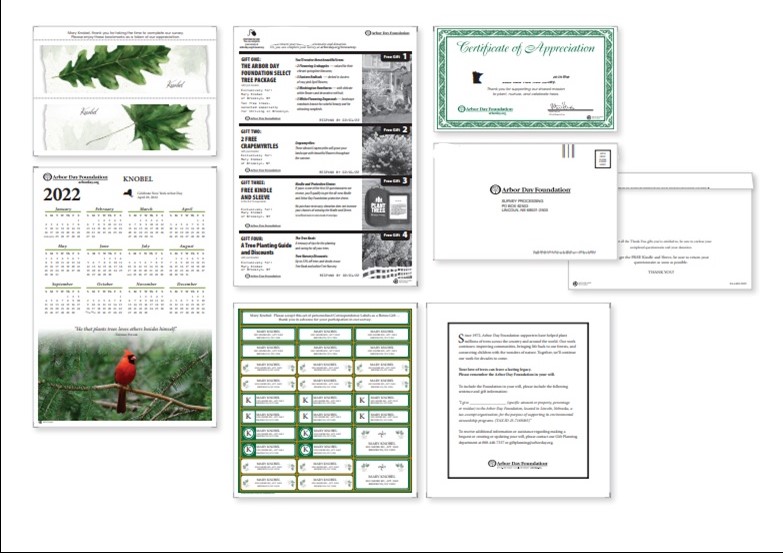For more than 20 years, the Arbor Day Foundation has worked with commercial printer RRD to create the direct mail pieces that have helped them grow and flourish. That partnership was no accident, built over years of mutual trust and respect, with direct mail remaining a centerpiece in the organization’s marketing efforts to this day.

The beginning, notes Tim Pietrini, senior direct marketing client strategist for RRD, was when the team met with John Rosenow, the founder of organization, who also happened to be “an old-school direct marketing fellow,” he says. “He was a true direct mail junkie. We went there to present some ideas, and he said we had 30 minutes. Two and a half hours later we got lunch. I think we were there for four hours talking about direct marketing, and that was how we began the first round of tests. It was very successful, and we carried on from there.”
Testing, in fact, remains a big part of why the Arbor Day direct mail campaigns continue to be so successful, says Woody Nelson, VP, Mission and Membership at the Arbor Day Foundation. “We are avid testers. We will try A versus B versus C to find out which one works. We will test on small universes of names, find one that’s a winner and go big with it. And we never stop testing — as soon as we have a winner, we start challenging it to find something even better.”
The process involves sitting down as a collaborative team after each successful direct mail campaign to brainstorm what worked and what could be improved, and come up with new ideas. “You would think after 20 years, we would have no new ideas, but we typically start with 30-35 new ideas on the board,” says Pietrini. They work hard to try to identify the campaigns that will appeal to new members, with he bulk of the direct mail campaigns specifically geared toward engaging new members and doners.
“It’s really collaborative in these meetings,” says Pietrini. “There is a cross section of people, with a lot of new ideas in the mix. Everyone has different perspectives and ideas, and we bounce those off what we know about the market.”
Right now, the ongoing direct mail campaign is a survey acquisition, that includes a variety of pieces in a single mailer to entice people to open and engage with it. It was first tested five years ago, and Nelson notes that it has evolved since then, and is now “full of great components, such as calendars, posters, brochures, an appeal letter, and vouchers,” just to name a new. The entire package is sent as a “max flat” — the largest flat piece you can mail through the USPS.
“Sometimes we get complaints about ‘why are you sending all this paper’,” says Nelson, “but the results are so phenomenal. We are proud to say that we garner enough results to plant 400 trees for every one we use.”
Pietrini notes that at the end of the day, even Arbor Day Foundation members and prospective members are still consumers, and while they love trees, this package alone sees around an 18% lift over other types of outreach programs. “They are still consumers,” he stresses, “they still react similarly [to direct mail.]”
That said, RRD and the Arbor Day Foundation are well aware of their audience. The pieces are created using recycled papers — Nelson notes that sometimes there might be an address label that isn’t, but everything else they print is made with recycled papers, and everything is printed with water-soluble ink technologies, making even the large direct mail packages very sustainable. “Our mission is to inspire people to plant trees,” says Nelson. “We are not tree huggers as much as we are loving trees for the benefits they provide. It’s a remarkable renewable resource, and we plant more trees than we ever use.”

That did cause a few challenges with the ongoing supply chain issues that have plagued the industry, but Pietrini notes that overall, the Arbor Day Foundation is good about sitting down and planning out their campaigns far in advance, making it easier to secure the consumables needed for each campaign. Only once, he notes, in January 2021, were they forced to scale back on a potential direct mail campaign because it was only 60-90 days out, and they just couldn’t secure the paper.
“We are always able to manage, making sure we’re out in front of [the supply chain] to do what we want to do,” says Nelson. “In that case, we wanted to go a bit beyond the original plan, but we were not able to do it.”
“It was a sad day when we didn’t have the capacity for that request,” says Pietrini. But that said, he does note that they are starting to see paper supplies loosen up, which is aa good sign we are on the upswing on that front, he continues.
While the Arbor Day Foundation has tested different options to stand out, and will use elements such as spot varnish, Nelson notes that some things, like gold foil, come across as “gimmicky” to the members, and actually have the opposite effect on the mailings, Instead, the team relies more on the advances of digital technologies, and the ability to personalize more than just a name and address to help stand out.
In fact, a single mailing today could have upwards of 90-100 different versions, with everything from the message to the type of tree featured in the imagery changing based on region, demographic, or other elements the organization is testing. Pietrini points out that the digital technologies RRD has invested in help to foster the ability to produce these complex mailings while keeps costs for both production and postage as low as possible.
“The ability to implement segmenting and variability is a huge part of our success,” says Nelson. “Over the years we’ve been able to find results and success with new tests and rolling out and improving on response rates. In fact, we have improved enough to offset the rising postal costs.”
Pietrini does note that one of the things they are currently testing are elements such as lower cost paper options, and more postal friendly sizes that might help bring costs down, but at the end of the day, they will produce the campaigns that get results — cost won’t be the ultimate determining factor as to what direct mail pieces actually get rolled out on a wider scale.
But no matter what the future holds, Nelson doesn’t foresee a time when direct mail isn’t a primary component of their marketing efforts in a substantial way. “Being present year in and year out is what the name of the game is for us,” he notes. “We have tried to be very methodical and authentic about it, and always present. While others might pull back, or shift to other channels to save money, our approach is to do what’s right. We can always add channels and use social media, but direct mail is a stalwart for us, and what’s next is to keep being the credible, consistent foundation we have always been.”
Direct mail, stresses Pietrini, works as well today as it did 30 years ago — it just has to be done correctly. Discipline, and a willingness to keep testing new ideas are key, “and Arbor Day is a classic example of that,” he says.
“The world needs trees now more than ever,” says Nelson. “The world and humankind needs them for clean water, clean air, and protection from heat and catastrophic storms — climate change. We have to be there pursuing the mission and getting more people into the boat.” And direct mail, he stresses, is how they plan to get there.

Toni McQuilken is a senior content editor for the NAPCO Media Printing and Packaging group.